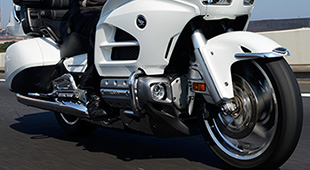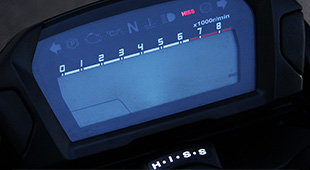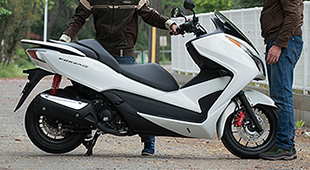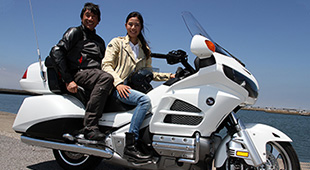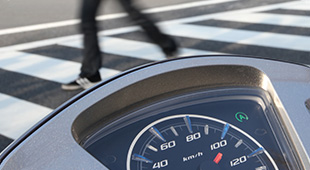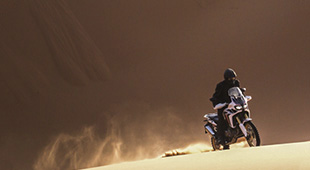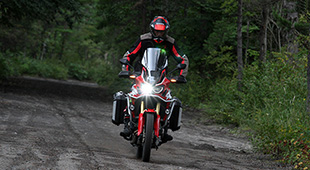Tech Views — Vol. 9 G Switch and Selectable Torque Control
Interview (1/2)
What effect do these two switches have?
In what way are they effective?
Discovering answers through experimentation.
Honda’s motorcycle Dual Clutch Transmission (DCT) has the same fundamental construction as the multi-gear transmissions featured on many of its sports bikes. However, clutch operations, including those performed when starting, stopping or changing gears, have been automated with the computerized control of the system’s two separate clutches.
DCT is not merely an automatic device designed to simplify riding, although it is a mechanism that performs all gear changing operations. Instead, DCT is a mechanism developed to provide a deeper enjoyment of riding.
Many people think that DCT is simply an automatic device designed to make riding easier. They know that by simply moving a switch from ‘N’ (Neutral) to ‘D’ (Drive) and twisting the throttle they can start riding, powering off from stop with no need to shift gears or operate the clutch. This may be a big part of the reason for people’s misconceptions about Honda’s DCT. What they may not know is that with this DCT, riders can also freely perform upshifts and downshifts at any time, and if they select the ‘M’ (Manual) mode, they can shift the gears for themselves whenever they like while riding.
The Africa Twin features the latest version of DCT, and settings have been updated for various operations such as start and speed changes. Even when riding in D mode, which is programed to perform all gear shifts automatically, it feels as if the gears were shifting in direct response to your very thoughts. Moreover, to enhance the feeling of the two-cylinder engine’s power pulses and torque, the Africa Twin’s full character is expressed with an early upshift program at its base.
Further, when the S (Sport) mode is selected, the DCT transforms itself with another shifting program that not only allows more aggressive riding, it also tracks the rider’s intent more closely by monitoring throttle position angle. This lets riders enjoy whatever type of performance they prefer to such a degree that they no longer feel the need to shift manually. Because of this, when you ride a DCT-equipped motorcycle, you’ll soon feel the delight of being able to do more and do it more satisfyingly than you’ve ever been able to on existing manual transmission (MT) models.

Riders are not only relieved of the bother of constant clutch operations, any concerns about occasional missed shifts or engine stalls when starting or stopping have also been virtually eliminated, giving the rider an incredible sense of security and confidence. Another feature of Honda’s DCT that surprises riders is the degree to which feelings of fatigue, both physical and mental, are alleviated. Above all, riders soon notice how much the physical operations of riding standard manual transmission bikes, which involve manipulating a clutch lever and changing gears, tend to consume more of their personal ‘CPU’ than expected. By leaving all operations related to the clutch and gear shifting to the DCT, the sense of relaxation riders get greatly increases the sense of enjoyment while enabling them to better concentrate on the other aspects of riding, or simply taking in the view. In other words, riders come to feel all the sensory delights of motorcycling more deeply and derive more satisfaction from their time on the road. This is truly the DCT’s most significant feature. And yes, the longer one’s experience riding motorcycles, the more one feels that the DCT injects a new kind of magic into the ride.
Among the various motorcycle models Honda has equipped with DCT, the CRF1000L Africa Twin has attracted by far the greatest attention. This on-road/off-road riding machine is a revival of one of Honda’s legendary models, which was a pioneer of a new Adventure Touring category that has grown over the ensuing years to enjoy worldwide popularity. As the name suggests, motorcycles in this category are equipped with performance features that make riders feel that they can travel to the far corners of the world. That is to say, these machines have been built to offer both the easy enjoyment of riding on paved roads as well as allowing one to confidently venture off road whenever the urge arises — a design feature that soon became one of its major points of appeal.
I’ve ridden the new Africa Twin several times now, and experienced its excellent attributes in various environments. I was especially impressed by my experience riding its DCT version off road, and was so surprised by its performance that I had to say, “Simply getting rid of the clutch lever remarkably expands your range of riding possibilities!”
When starting out on the MT (Manual Transmission) version, like with any normal motorcycle, you pull in the clutch, put it into first gear, then ease out the clutch while slowly rolling on the throttle to get moving. However, when riding off-road, depending on road surface conditions, this is a procedure that requires a lot of concentration to avoid spinning the rear tire or stalling the engine.
Whenever riders feel stressed by riding an MT model off-road, they tend to overrev the engine or slip the clutch a little too long, thus causing one’s feelings to come out in the operation of the bike. Conversely, the DCT version of the Africa Twin starts out with astonishing ease, and then goes on to perform the usual upshift operations automatically.
On that point, of all the various DCT-equipped bikes I’ve ridden since 2010, the Africa Twin’s DCT has evolved to offer more advanced control and smarter shifting, as well as clutch settings that best match the needs of off-road riding, thus giving riders a fantastic assist.
Since the DCT changes gears without missing shifts, and provides excellent clutch operation even when accelerating, I found I could better focus my attention on the road conditions in front of me and my braking before turns, allowing me to concentrate more on the riding, including my timing in making turns and my cornering. For example, when faced with a lot of tight bends in a dirt road where I’ve got to reduce my speed to pass, on MT models it’s not unusual for some deft clutch operation to be required. In these cases, it’s also necessary to simultaneously stabilize the bike by lightly holding the grips without applying force to the wrists, while constantly being careful about what the left hand is doing with the clutch.
However, with the DCT model, since the rider is completely relieved of clutch operation, I found I could hold the grips lightly in hand while relaxing my elbows and shoulders, making it possible to more naturally bring out the machine’s full cornering capability. Especially in clearing tight left corners. Now this was an unexpected delight!
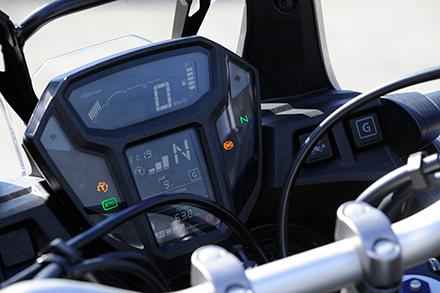
Such advantages are also true in the standing position one frequently uses when riding off-road. Since, as noted above, clutch and left foot shift operations are no longer required, I found I was relieved of having to adjust my riding position to allow me to perform these operations, and could instead concentrate on the basics of controlling the bike from a position that best suits both the road surface and the machine. This proved to be a great help on gravel roads, the sandy roads seen on off-road courses, climbing and descending steep hills, and continuous stretches of deep ruts.
This also applies when stopping. I found I didn’t need to be quite so conscious of gear changes, and could easily stop after checking to be sure there was a solid place to put my foot down. Even in places with large ruts, where it’s difficult to get a good foothold, I felt I could stop without getting overly stressed. This was like making a totally new discovery. Enough so that the image of DCT being something to make off-road riding even more enjoyable was firmly established in my mind by the end of my ride.
And how effective is this new function?
The Africa Twin was equipped with a G Switch to make DCT more suitable for off-road conditions.
So why was the G Switch added?
One reason is that this latest DCT system features “adaptive clutch control.” When the DCT changes gears, its two clutches operate in harmony for such smooth shifts that the bike accelerates through the gears without any perceptible interruptions in its driving force.
Further, with the DCT system, when the throttle is opened and closed, the clutch momentarily slips into a semi-clutch state that reduces driveline shock and helps realize exceptional riding comfort. Bike pitching due to variations in driving force is also efficiently and effectively suppressed.
The effect of such DCT control yields many advantages: For example, when riding two-up, rider and passenger helmets tend to bump against each other less during upshifts and downshifts. Also, even when the throttle is used somewhat roughly in low-speed maneuvers, jerky front and back movement is suppressed for more comfortable handling.
On the other hand, according to the DCT’s development engineers, this smooth control can give the rider the impression that there’s a delay in the drive’s response to throttle inputs, especially when wanting to perform quick maneuvers while off-road riding.
I was told that this delay is in the range of units of hundredths or thousandths of a second, but in order to create more of a feeling of uniformity there was a request for modifications to the DCT’s settings as well, particularly as they relate to the engagement and release of the clutch. In short, the G Switch was designed to improve the feeling of uniformity between the throttle and the rear wheel when riding off-road.
The effects of the G Switch can be easily felt when making low-speed turns on woodland paths or when taking advantage of slippery road surfaces, such as on gravel roads, by quickly blipping the throttle to slide the rear wheel. In these and other situations, I could clearly feel the difference.
After the road test, I remembered these favorable impressions and tried to explain the Africa Twin’s DCT to a riding friend of mine. But then he asked me a question: “So how effective is the G Switch?” Although I’d given him my subjective impression, he said he’d like me to explain it again more objectively. I found that I couldn’t communicate it very well to him, since he rides road bikes and lacks off-road riding experience. I had to think about it all again...
Then he asked me another question: “How do those 4 levels of Selectable Torque Control change its operation?”
My explanation that “there’s absolutely nothing to be afraid of when cracking open the throttle on a dirt road,” only reflected the perspective of someone like me who has some experience riding big bikes like the Africa Twin on dirt roads. If the rider is reluctant to open the throttle, this is often because of little or no off-road riding experience or a fear of sliding, even with a bit of off-road experience. Since this was his situation, it soon became obvious that we were just not on the same wavelength.
So, I decided to first contact the engineers who were involved in the development of the G Switch and Selectable Torque Control, and directly confirm operation with them, including questions about how best to grasp the difference in easy-to-understand terms. Answering my questions were team members Satoshi Seo, Masanori Nakamura and Asuka Ito.
- Top
- Interview
- Impressions

